Ever wondered which states in the USA boast the most majestic and leafy trees? We’ve got you covered! In this article, we’ll take a lively journey through the verdant landscapes of America to discover which states reign supreme when it comes to trees.
Picture yourself walking through a lush forest, the sun’s rays peeking through the emerald canopy above. With each step you take, you’re surrounded by the gentle rustle of leaves and the sweet scent of pine. Ah, what a serene experience! But wait, where exactly are you in this tree-filled wonderland?
Fear not, for we’ve gathered the latest data and crunched the numbers to uncover the greenest giants among the states. The contenders are fierce, but only a select few will emerge as the arboreal champions.
So, buckle up, nature enthusiasts, as we embark on this tree adventure together! Let’s dive into the realm of forests and foliage, exploring which states boast the highest tree population and discovering the factors that contribute to their lush, leafy prominence.

What Regions of the United States Have the Most Forests?
Beautiful habitats with considerable forest cover can be found throughout the United States. Besides providing a haven for a diverse range of wildlife, these green forests also benefit the local economy and provide recreation opportunities that allow people to get back in touch with nature.
Pacific Northwest
The Pacific Northwest, which includes the states of Washington and Oregon and even sections of Northern California, is home to some of the U.S.’s most massive and dense woods. Tall conifers like Douglas fir, redwoods, and western hemlock make these forests a sight to behold.
Northern Rocky Mountains
Large tracts of forest cover much of the Northern Rocky Mountains, an area that includes sections of Montana, Idaho, and Wyoming. Spruce, pine, and aspen are just a few examples of the conifers and deciduous trees that make up these woods, which are home to a wide range of animals.
Appalachian Mountains
The Appalachian Mountains, spanning from Georgia to Maine, are another significant forested area in the United States. These forests feature a mix of hardwood trees, including oak, maple, and hickory, supporting a wide range of plant and animal species.
Great Lakes Region
Great swaths of forest cover can be found in the Great Lakes states of Michigan, Wisconsin, and Minnesota. Many animals, including deer, bears, and birds, rely on these woods for survival because of the significant timber they provide.
With this in mind, let’s look at which states have the most trees in total!
1. Alaska
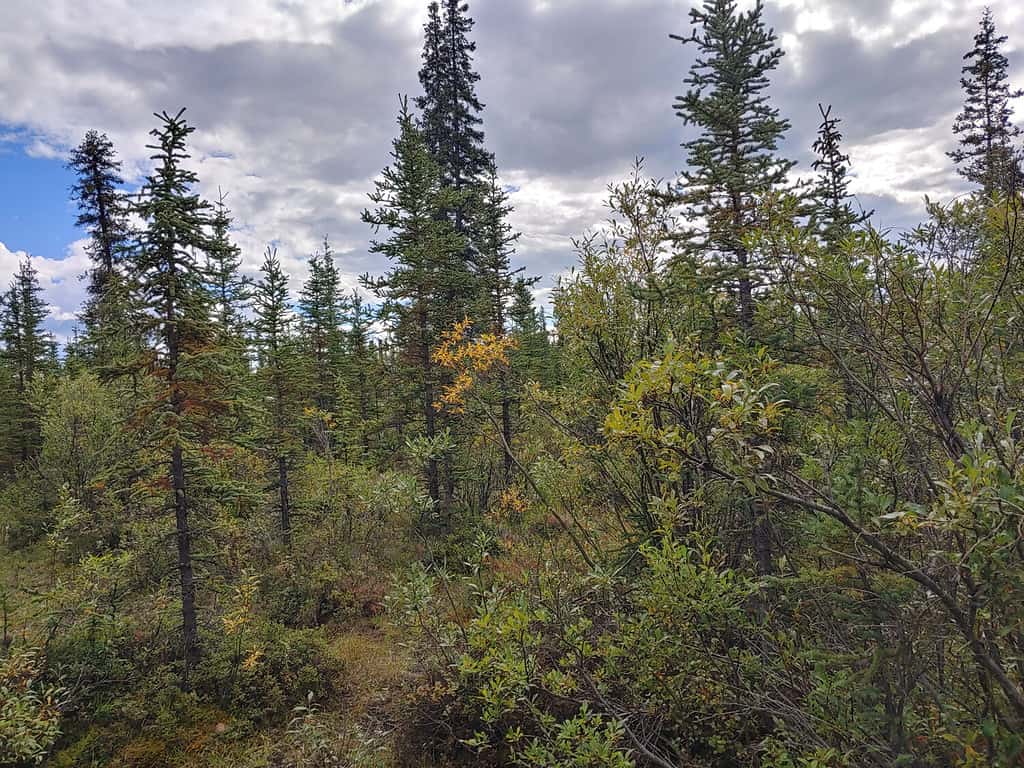
Alaska is known for its wide range of black spruce trees.
©Nungasak/Shutterstock.com
Number of Trees: 31,750,000,000
The expansive and breathtaking natural landscapes of Alaska make it the largest state in the United States. Alaska is home to an incredible 31,750,000,000 trees, making it the state with the most in the whole United States. This massive forest is vital to the health of the ecosystem and the survival of a wide variety of plant and animal life.
The vast woods of Alaska, covering about half of the state, are a verdant paradise for trees and plant life. The state’s chilly climate makes coniferous trees like spruce, pine, and hemlock the major species in these woodlands.
Ecological Importance: A Biodiversity Hotspot
The lush forest cover in Alaska is a crucial contributor to the state’s robust ecosystem. Numerous animals and birds, including bears, moose, wolves, and a plethora of species of birds, rely on these woodlands for their survival. These forests provide a vibrant environment that is critical to the survival of many different species due to the huge range of plant and animal life found there.
The large amount of tree cover in Alaska is crucial in maintaining a comfortable temperature year-round. Trees store carbon dioxide they take up during photosynthesis as biomass, making them effective natural carbon sinks. Reduced greenhouse gas emissions and climate change are two of the benefits of this method.
Economic Importance: Timber Resources
Beyond its ecological significance, Alaska’s trees also hold economic value. The state’s timber industry relies on sustainably harvesting trees for lumber and other forest products, contributing to the state’s economy and supporting local communities.
Given the essential role Alaska’s forests play in the environment and economy, efforts to preserve and manage these woodlands sustainably are of paramount importance. Conservation measures, responsible logging practices, and protected areas all play a part in safeguarding Alaska’s green legacy for future generations to come.
2. Texas
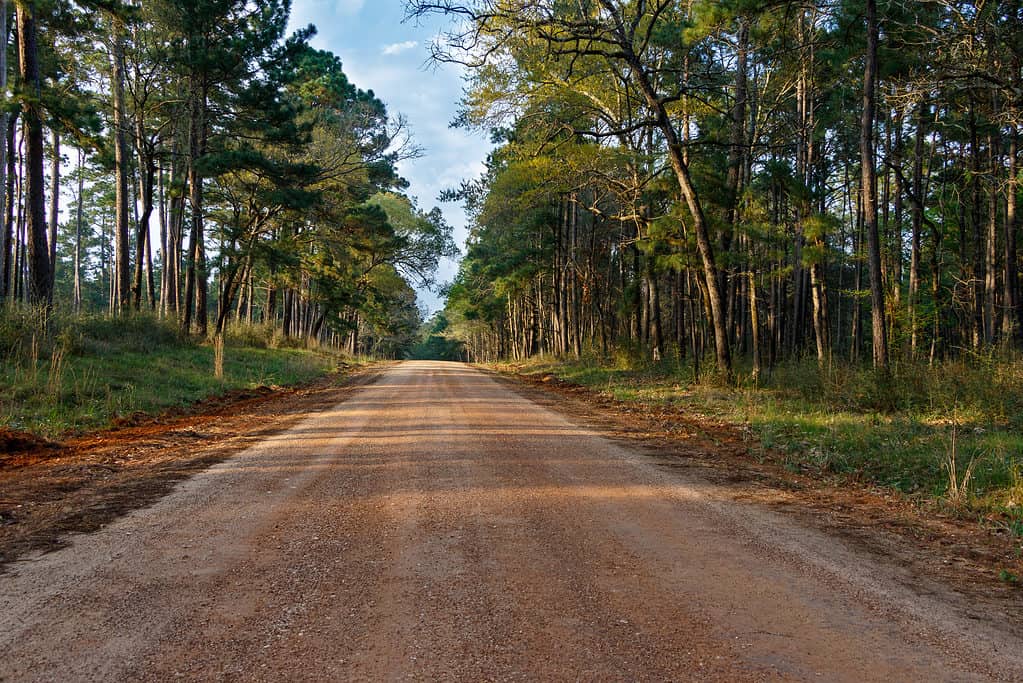
The Sam Houston National Forest in Texas.
©Tyler Stuard/Shutterstock.com
Number of Trees: 15,600,000,000
Forests in Texas might not be the first thing that comes to mind when you think of the Lone Star State, which is better recognized for its expansive grasslands and rough terrain. However, second only to California in the number of trees per square mile, Texas ranks quite high. The state’s varied terrain conceals a surprising wealth of greenery: an estimated 15,600,000,000 trees.
Texas’s tree population encompasses various forest types, each adapted to the state’s diverse climates and geography. Eastern regions boast dense woodlands filled with oak, hickory, and pine trees, while the west features juniper and oak savannas. Just as well, along the Rio Grande, native palm trees known as sabal palms thrive in the subtropical climate.
Environmental Significance
These trees in Texas are vital to the health of the ecosystem. Deer, rabbits, and many species of birds all rely on them as critical habitats. The woods not only help to stabilize the soil, but they also stop erosion and keep runoff from contaminating the water supply.
Apart from their ecological importance, Texas’s trees offer valuable economic benefits. The state’s forestry industry provides jobs and contributes to the economy through the production of timber, wood products, and paper. Just as well, the forests offer recreational opportunities for locals and tourists alike, providing spaces for hiking, camping, and nature appreciation.
Challenges and Conservation Efforts
Texas has a lot of trees, yet it still has to deal with issues like deforestation, urbanization, and the risk of wildfires. The goal of conservation is to preserve and responsibly manage the state’s forests for future generations.
As Texas continues to grow and develop, preserving its impressive tree population becomes increasingly critical. Balancing human needs with ecological preservation is essential to safeguarding Texas’s natural heritage and maintaining the invaluable benefits that its trees provide for the environment, economy, and people’s well-being.
3. Montana
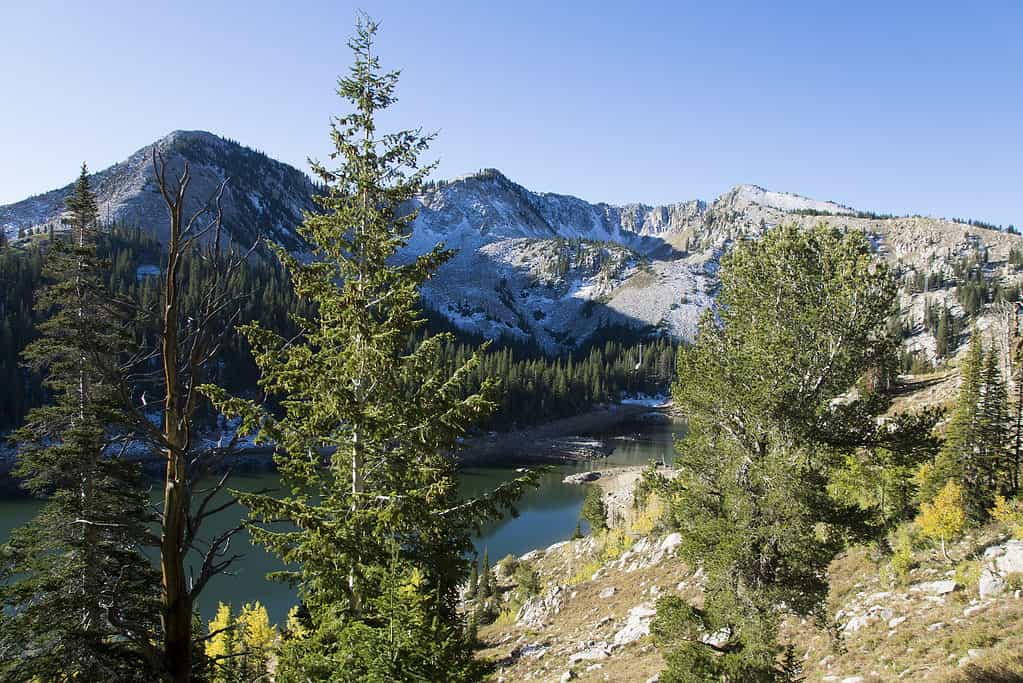
Douglas firs are one of the most common types of trees in Montana.
©IrinaK/Shutterstock.com
Number of Trees: 6,375,000,000
Montana, often celebrated for its breathtaking mountains and vast prairies, holds a hidden secret: it ranks third among U.S. states with the most trees! Boasting approximately 6,375,000,000 trees, Montana’s expansive forests are a remarkable feature of its diverse landscape.
Montana’s tree population encompasses a wide variety of species, reflecting the state’s range of climates and terrains. Lush evergreen forests of spruce, fir, and pine thrive in the colder mountainous regions, while hardwoods like aspen and cottonwood grace the lower valleys and riverbanks.
There wouldn’t be an ecological equilibrium in Montana without the trees. Elk, deer, and many different kinds of birds all call these areas home because of the habitats they provide. Just as well, these woods improve soil fertility, stop erosion, and keep water in rivers and streams in good condition.
Beyond their ecological importance, Montana’s trees offer economic advantages through the timber industry. Sustainably managed forestry practices ensure the state can harvest trees for lumber and other products while preserving the health and longevity of its forests.
Recreational Opportunities and Nature’s Beauty
Montana’s forests also provide valuable recreational opportunities. Residents and visitors can enjoy hiking, camping, and wildlife observation in these pristine woodlands, connecting with nature’s tranquility and beauty.
Despite its abundant tree cover, Montana faces challenges such as wildfires, pests, and deforestation. Conservation efforts aim to mitigate these threats and protect the state’s forested areas for future generations to enjoy.
Preserving Montana’s status as one of the top tree-rich states demands responsible stewardship and conservation efforts. By valuing and safeguarding its trees, Montana can sustain its natural heritage, ensuring that these forests continue to thrive, benefiting both its people and the environment.
4. Georgia
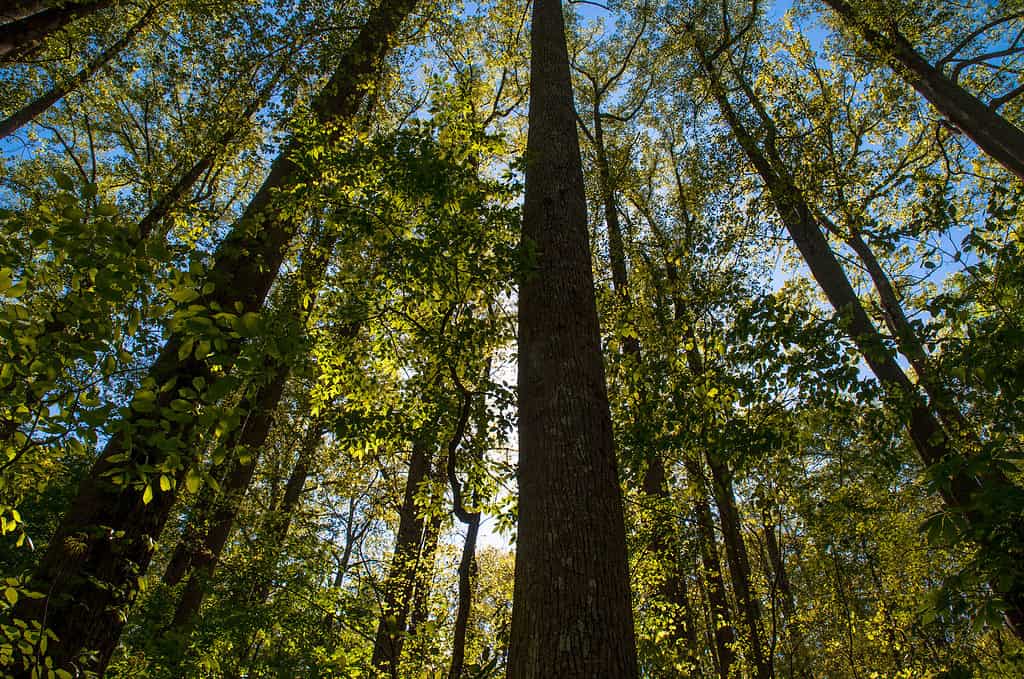
The Chattahoochee National Forest in Georgia features a wide variety of trees.
Number of Trees: 6,200,000,000
Georgia, nestled in the southeastern region of the United States, is renowned for its warm climate and rich history. What may come as a surprise to many is that Georgia is the proud bearer of the fourth most trees in the country, boasting an impressive total of approximately 6,200,000,000 trees. Amidst its bustling cities and picturesque landscapes lies a verdant treasure of forests.
Diverse Forest Types
The flora of Georgia mirrors the state’s cultural and geographical diversity. Oak, pine, hickory, and cypress are just some of the many tree types that thrive in the state’s woodlands. Forest ecosystems are found all over Georgia, from the state’s northern mountains to its southern coastal plains.
Trees like these are extremely important to Georgia’s ecosystem. They’re essential to the survival of a wide variety of animals, from regal white-tailed deer to brilliant migrating birds. Humans and the environment both benefit from these forests because they improve soil health, reduce erosion, and increase water quality.
Beyond their ecological significance, Georgia’s trees hold economic value. The state’s forestry industry plays a crucial role in the economy, providing jobs and producing timber and wood products. Just as well, the forests offer recreational havens for outdoor enthusiasts, providing opportunities for hiking, camping, and nature appreciation.
Conservation and Sustainability
With growing urbanization and development, preserving Georgia’s forests becomes essential. Conservation efforts aim to balance human needs with environmental protection, ensuring sustainable forest management and safeguarding these valuable natural resources.
In terms of natural resources and environmental protection, Georgia stands out as one of the top states for its abundance of trees. Georgia protects the health of its ecosystems and wildlife by caring for and safeguarding its trees, and in doing so, provides inhabitants and visitors with the opportunity to enjoy the peaceful beauty of the state’s abundant forested landscapes.
5. Colorado
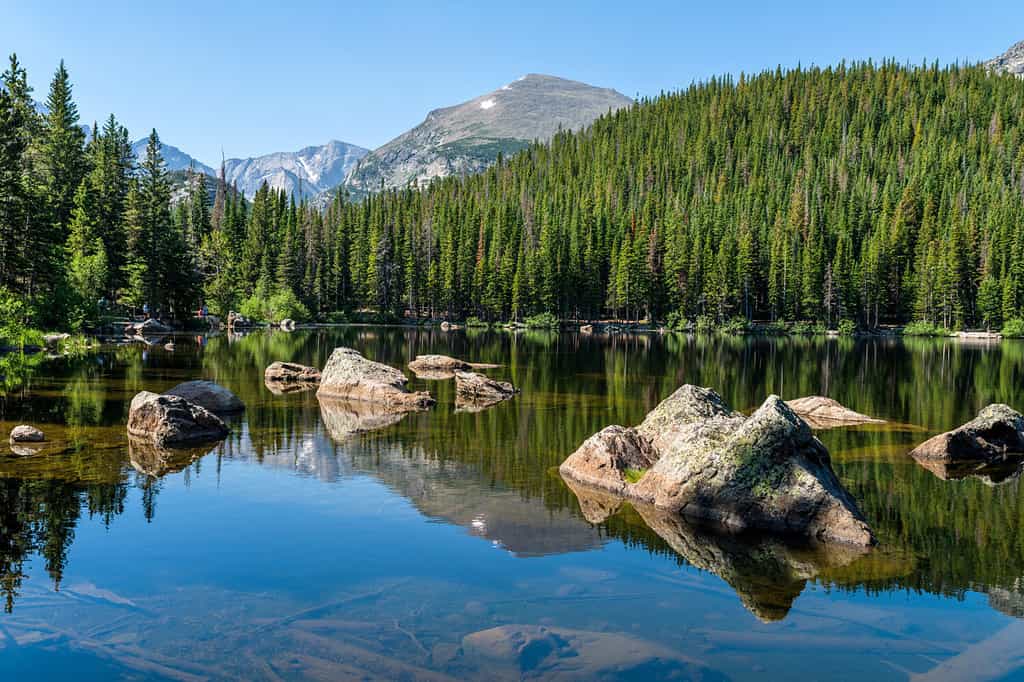
Colorado’s forests consist of a diverse mix of tree species, including pine, spruce, fir, and aspen.
©Sean Xu/Shutterstock.com
Number of Trees: 6,100,000,000
Colorado is renowned for its majestic Rocky Mountains and breathtaking landscapes. It also claims a spot among the top tree-rich states in the United States. With an impressive total of approximately 6,100,000,000 trees, Colorado’s forests add to the state’s allure and natural beauty.
Diverse Forests at High Altitudes
Colorado’s tree population thrives amidst its varying altitudes and terrains. The state’s forests consist of a diverse mix of tree species, including pine, spruce, fir, and aspen. From the foothills to the alpine regions, these forests adapt to the mountainous climate, creating distinct ecological niches.
The trees in Colorado hold significant ecological importance. They provide crucial habitats for various wildlife species, including elk, mule deer, and numerous bird species. Additionally, the forests contribute to soil stability, prevent erosion, and help maintain water quality in the state’s rivers and streams.
Recreational Opportunities and Scenic Beauty
Beyond their ecological value, Colorado’s trees offer immense recreational opportunities for residents and visitors alike. The state’s forests provide a paradise for outdoor enthusiasts, offering activities such as hiking, skiing, and camping amidst the serene wilderness.
6. Alabama
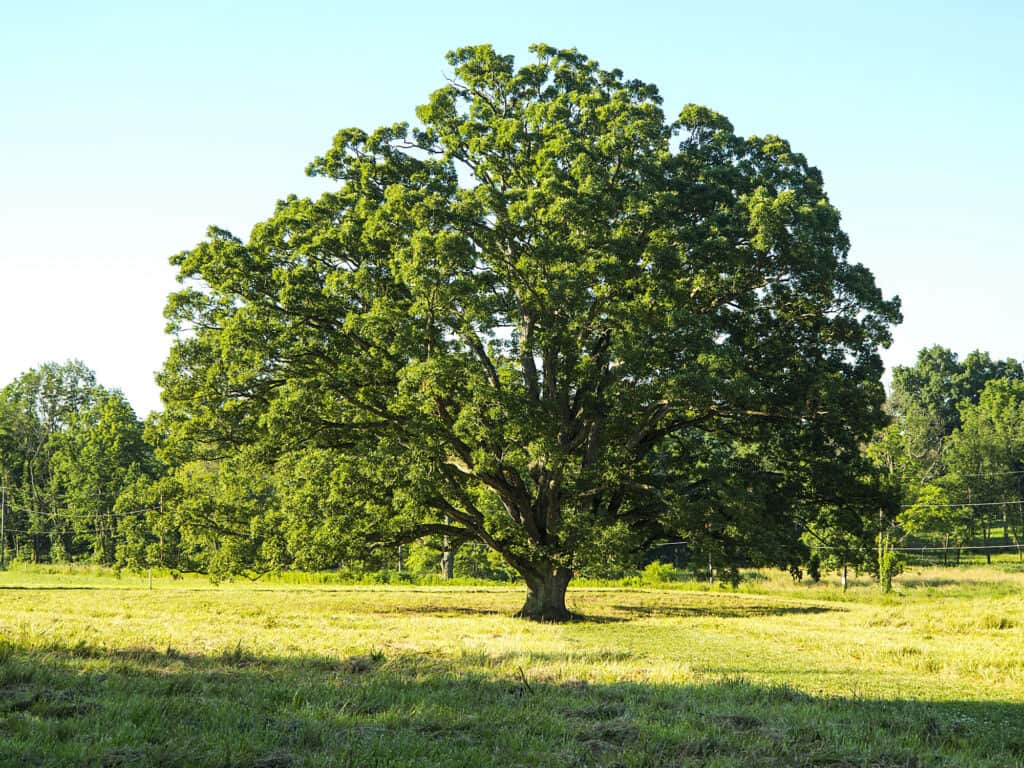
White oaks are a common tree species found throughout Alabama.
©iStock.com/Cris Andrei
Number of Trees: 5,700,000,000
Alabama, nestled in the heart of the American South, is celebrated for its warm hospitality and charming landscapes. Beyond its cultural riches, Alabama boasts a notable natural treasure: the sixth most trees in the United States. With a total of approximately 5,700,000,000 trees, the state’s lush woodlands add to its southern charm and ecological wealth.
Alabama’s tree population encompasses a diverse array of species, reflecting its varied geography and climates. From the oak-hickory forests in the north to the pine flatwoods and cypress swamps in the south, each region offers unique forest ecosystems. The state’s coastal areas also feature stunning maritime forests along the Gulf of Mexico.
Alabama’s forests offer a wide variety of activities for both locals and tourists. People can appreciate the natural environment and its splendor by engaging in activities like hiking, hunting, and nature appreciation in the woods.
Economic Benefits and Sustainable Forestry
Beyond their ecological significance, Alabama’s trees offer economic advantages. The forestry industry contributes to the state’s economy through timber production, creating job opportunities and supporting local communities. Responsible forest management practices aim to preserve the long-term health and viability of these forested areas.
Alabama’s forests provide ample recreational opportunities for residents and visitors alike. The woodlands offer spaces for hiking, hunting, and nature appreciation, allowing people to connect with the beauty of the natural world.
7. Washington

Washington is home to towering coniferous forests in the Cascade and Olympic Mountains.
©Wirestock Creators/Shutterstock.com
Number of Trees: 5,500,000,000
The Pacific Northwest state of Washington has the seventh-highest tree population in the United States. The verdant forests of this state, home to an estimated 5,500,000,000 trees, are a sight to behold.
A Tapestry of Forest Types
Washington’s varied landscape helps create a wide variety of forest kinds. Douglas fir, western hemlock, and cedar are just a few of the many tree species that call Washington State home. The state is home to towering coniferous forests in the Cascade and Olympic Mountains as well as temperate rainforests near the coast.
The trees of Washington are vital to the state’s ecosystem. Elk, black bears, and many bird species rely on them as critical habitats. Just as well, these woods improve soil quality, stop erosion, and protect the state’s water supply.
Economic and Recreational Opportunities
Beyond their ecological importance, Washington’s trees offer valuable economic benefits. Timber production and related industries in the forestry industry boost the state’s economy. In addition to allowing people to see the wonders of nature up close and personal, these forests provide a wide variety of outdoor activities.
Summary of the Top 7 States with Absolute Most Trees in the Country
| # | State | # of Trees |
|---|---|---|
| 1 | Alaska | 31,750,000,000 |
| 2 | Texas | 15,600,000,000 |
| 3 | Montana | 6,375,000,000 |
| 4 | Georgia | 6,200,000,000 |
| 5 | Colorado | 6,100,000,000 |
| 6 | Alabama | 5,700,000,000 |
| 7 | Washington | 5,500,000,000 |
Thank you for reading! Have some feedback for us? Contact the AZ Animals editorial team.








